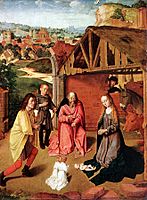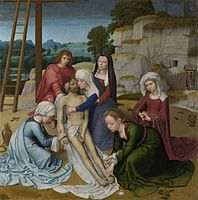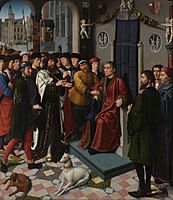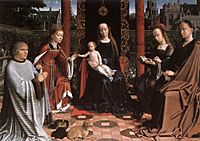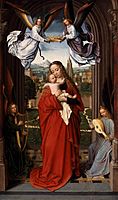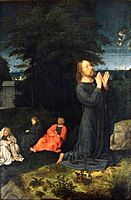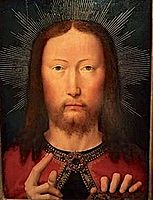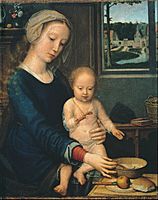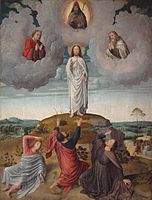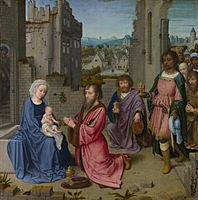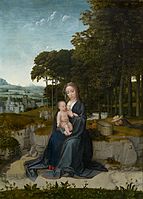Gerard David facts for kids
Gerard David (around 1460 – 13 August 1523) was an important Early Netherlandish painter and manuscript illuminator. He was known for his amazing use of color in his artworks. We don't know a lot about his life, but some facts have been discovered.
He might have been the "Meester gheraet van brugghe" who became a master of the Antwerp guild in 1515. Gerard David was very successful during his lifetime. He probably managed two art workshops, one in Antwerp and one in Bruges. Like many artists of his time, his fame faded in the 1600s. But he was rediscovered and became famous again in the 1800s.
Contents
Life of Gerard David
Gerard David was born in Oudewater, a town now in the Utrecht province. He was likely born between 1450 and 1460. This guess is based on how old he looks in his self-portrait from 1509.
It is thought that he spent time in Italy from 1470 to 1480. There, he was influenced by the Italian Renaissance, a period of great art and learning. He first developed his painting style under Albert van Oudewater in Haarlem.
In 1483, David moved to Bruges, a busy city for art. He joined the Guild of Saint Luke there in 1484. This guild was like a club for artists. After Hans Memling, another famous painter, died in 1494, David became the top painter in Bruges.
He became the leader of the guild in 1501. In 1496, he married Cornelia Cnoop. Her father was the head of the goldsmiths' guild. David was a well-known and respected citizen in Bruges.
A painter named Ambrosius Benson trained with David. However, they had a disagreement around 1519. Benson had collected many paintings and drawings from other artists. David refused to give them back because Benson owed him a lot of money. Benson took David to court and won the case. This led to David being briefly held for the dispute.
Gerard David passed away on August 13, 1523. He was buried in the Church of Our Lady in Bruges.
Gerard David's Painting Style

Most of David's surviving paintings show religious scenes. His works are known for being calm and almost dreamlike. He created this feeling using soft, warm, and gentle colors. He was also a master at using light and shadow.
David was creative in how he painted traditional subjects. He also had a new way of showing landscapes. Landscape painting was just starting to become popular in northern Europe. You can see his skill with landscapes in the detailed leaves of his Triptych of the Baptism. The forest scene in his New York Nativity also shows this talent.
In the early 1900s, some art historians thought David just copied other artists. They believed his style was old-fashioned and not very imaginative. However, today, most people see him as a master of color. The Metropolitan Museum of Art describes him as a "progressive" painter. They say he moved beyond older styles with a "purity of vision" during a time of change in art.
In his early works, David followed artists from Haarlem like Dirk Bouts. He also learned from Albert van Oudewater and Geertgen tot Sint Jans. Even then, he showed great talent with colors. Paintings like the St John in Berlin and the St Jerome are from this early time.
When he moved to Bruges, he was greatly influenced by Memling. David learned from Memling to create serious and realistic human figures. He also learned to arrange figures in an orderly way.
In 1515, David visited Antwerp. He was impressed by the work of Quentin Matsys. Matsys had brought more life and personal feeling to religious paintings. David and Matsys worked together to keep the traditions of the Bruges art school alive. They wanted to protect it from the new ideas of the Italian Renaissance.
Famous Works by Gerard David
Some of David's most famous works are the altarpieces he painted before his visit to Antwerp. These include the Marriage of St Catherine in London. Another is the Madonna Enthroned and Saints in Genoa, Italy. The Annunciation in Sigmaringen is also well-known.
His most famous work is probably the Madonna with Angels and Saints. It is often called The Virgin among the Virgins. He gave this painting to the Carmelite Nuns of Sion in Bruges. It is now in the Rouen museum.
Only a few of his paintings are still in Bruges. These include The Judgment of Cambyses and the Baptism of Christ. Both are in the Groeningemuseum. The Transfiguration is in the Church of Our Lady.
Many of his other works are now spread across the world. This might be why his name was forgotten for a while. Some people also thought he didn't add anything new to art history. They believed he only made new versions of older artists' work.
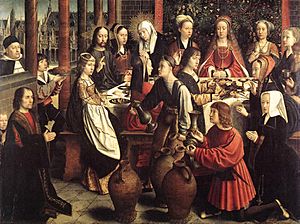
However, his importance among great artists was recognized again in 1902. Many of his paintings were brought together for an exhibition in Bruges. This show was called the "Exposition of Early Flemish Painters."
David also worked closely with top manuscript illuminators. These artists decorated books with beautiful pictures. It seems David himself painted important small pictures for these books. These include a Virgin among the Virgins in the Morgan Library. Another is a Virgin and Child on a Crescent Moon in the Rothschild Prayerbook. He also painted a portrait of Emperor Maximilian in Vienna.
Several of his drawings still exist today. Parts of these drawings can be seen in the works of other painters. They were used by illuminators for many years after David's death.
Works by David can also be found in Spanish museums. The Museo del Prado in Madrid has a painting called "Rest on the Flight into Egypt." It is similar to one in the Royal Museum of Fine Arts in Antwerp. The Prado also has two other works by David, though one is only thought to be by him. The Thyssen-Bornemisza Museum in Madrid has a "Crucifixion" from 1475.
Gerard David's Legacy
When David died, Bruges was losing its importance as an art center. Antwerp had become the new leader in art, business, and politics. Of David's students in Bruges, only Adriaen Isenbrandt, Albert Cornelis, and Ambrosius Benson became well-known. Other Flemish painters like Joachim Patinir and Jan Mabuse were also influenced by him.
Gerard David's name was completely forgotten for many years. Then, in 1866, William Henry James Weale found documents about him in Bruges. These documents revealed important facts about the painter's life. This led to his artistic identity being put back together. It started with recognizing his only documented work, The Virgin Among Virgins in Rouen.
Gallery
-
Lamentation, c 1495–1500. National Gallery, London, UK
-
Altarpiece of St Michael c. 1510. Kunsthistorisches Museum, Vienna
-
Virgin and Child with Four Angels, c. 1510–1515. Metropolitan Museum of Art, New York
-
Adoration of the Kings, 1515–1523, National Gallery, London
-
Joos van der Burch and Saint Simon of Jerusalem, c. 1493, Fogg Museum at the Harvard Art Museums
See also
 In Spanish: Gerard David para niños
In Spanish: Gerard David para niños





